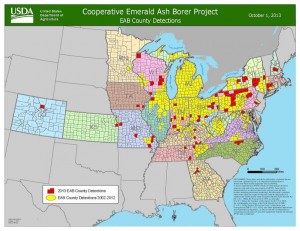Emerald Ash Borer Update: October 2013
Please see our 2016 Update for up-to-date information on the spread of Emerald Ash Borer in New Jersey and Pennsylvania.
 This invasive insect is threatening the extinction of Ash trees in states and areas that it has moved into. Prior to June 2002, it had never been found in North America. Eleven years later, the Emerald Ash Borer (EAB) is considered to be the most destructive pest ever seen in North American forests. Drive through interstates or suburban developments and you will see bare Ash trees or stumps where they once stood.
This invasive insect is threatening the extinction of Ash trees in states and areas that it has moved into. Prior to June 2002, it had never been found in North America. Eleven years later, the Emerald Ash Borer (EAB) is considered to be the most destructive pest ever seen in North American forests. Drive through interstates or suburban developments and you will see bare Ash trees or stumps where they once stood.
Luckily, in New Jersey, EAB have not yet been detected! A comprehensive plan is in place by the US Department of Agriculture (USDA) and exhaustive steps are being taken to quarantine and reduce the spread of the EAB. The map to the left shows new county detections during 2013 in red. Note some of the protection that the Delaware River helps to provide as a natural hurdle to its spread into New Jersey.
 The Emerald Ash Borer is a metallic green beetle about 1/2″ long and 1/8″ wide.
The Emerald Ash Borer is a metallic green beetle about 1/2″ long and 1/8″ wide.
Adults emerge in early May through late June and begin laying eggs 2 weeks later. Once they hatch, the larvae bore through the bark into the cambium of the tree where they feed, disrupting the flow of water and nutrients to the canopy of the tree. While EAB will also attack healthy Ash trees, it’s believed that they prefer to lay eggs and feed on stressed trees.
What can YOU do?
First, keep your Ash trees as healthy as possible. Consider Deep Root Fertilizing the most important trees on your property and irrigate them during prolonged drought periods. Healthy trees can better withstand disease and insect pressure.  Secondly, when buying firewood, know the source of the wood. DO NOT MOVE any firewood or logs outside quarantined areas and DO NOT ACCEPT wood from these areas. Lastly, know that the USDA and your Extension offices are monitoring traps throughout New Jersey (and other areas of the country). If you see what you suspect is an EAB, call your local Extension office or Certified Tree Expert. Try to capture it for positive identification.
Secondly, when buying firewood, know the source of the wood. DO NOT MOVE any firewood or logs outside quarantined areas and DO NOT ACCEPT wood from these areas. Lastly, know that the USDA and your Extension offices are monitoring traps throughout New Jersey (and other areas of the country). If you see what you suspect is an EAB, call your local Extension office or Certified Tree Expert. Try to capture it for positive identification.
There are prophylactic measures that can be taken as well. Pesticides are available that are injected into the cambium of the tree, preferably well before an infestation occurs.
As a NJ Certified Tree Expert and NJ Approved Forester, contact us at any time to come out to evaluate your important landscape trees and develop an appropriate Plant Health Care (PHC) plan.
GET THE LATEST NEWS
Subscribe to the Organic Plant Care Newsletter and get timely and helpful tips and updates monthly.
There's no spam - we promise!





